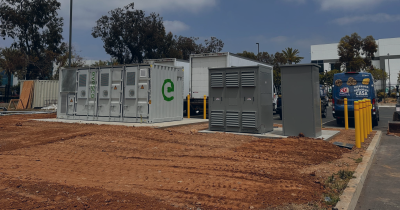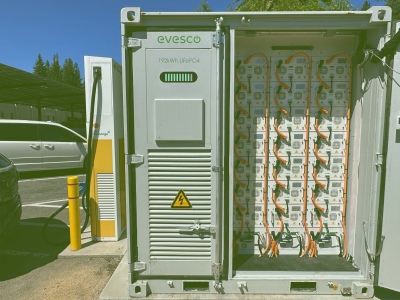Types of Electric Vehicles – A Complete Guide

The EV market is booming, with new models of electric vehicles becoming available all the time. From hot hatchbacks and coupes to SUVs and pickup trucks. But what is the difference between the types of electric vehicles and cars available? Some electric vehicles run solely on battery power; others, known as hybrids, combine an electric motor with an internal combustion engine in various ways. Then, there are fuel cell electric vehicles and even solar electric cars. This guide to the different types of electric vehicles will provide an overview of the types of EVs and how they work.
BATTERY ELECTRIC VEHICLES (BEVs)
Battery Electric Vehicles (BEVs), or all-electric vehicles, run entirely on electricity with no gasoline engine. They use one or more electric motors powered by rechargeable lithium batteries, chosen for their high power-to-weight ratio and compact size. BEV battery packs charge via EV chargers—Level 1 being the slowest, Level 3 the fastest.
BEVs produce zero emissions, and current models offer ranges of 50–350 miles per charge, with newer models like the 2022 Lucid Air Dream Edition exceeding 500 miles.
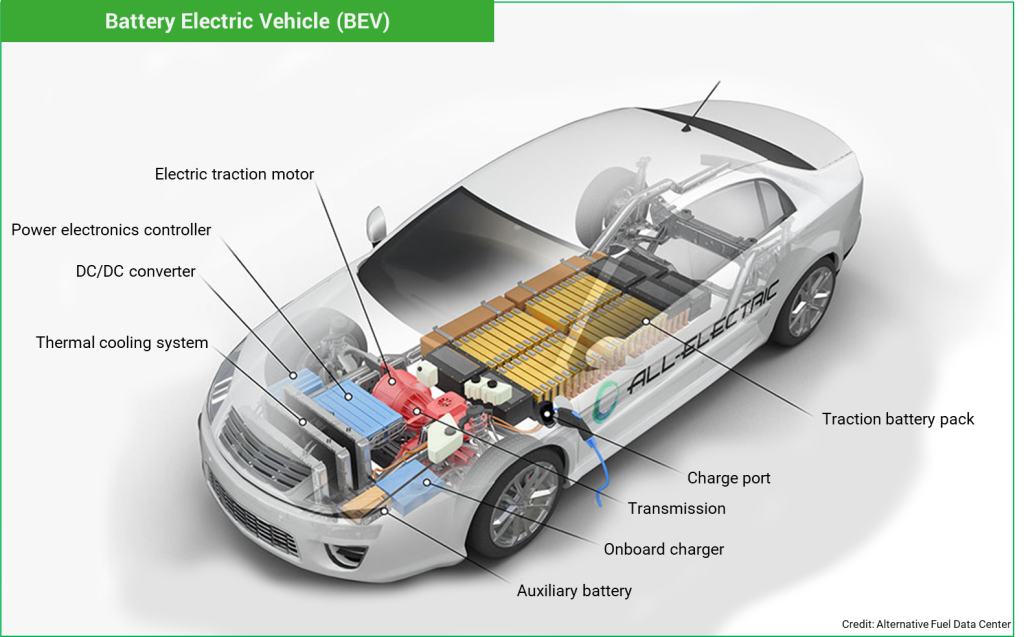
EXAMPLES OF AVAILABLE BATTERY ELECTRIC VEHICLES (BEVs)
- Audi e-tron
- BMW i4
- Chevrolet Bolt EV
- Ford Mustang Mach-e
- GMC Hummer EV
- Hyundai Ioniq Electric
- Jaguar I-Pace
- Kia EV6
- Lucid Air
- Mercedes EQS
PLUG-IN HYBRID ELECTRIC VEHICLES (PHEVs)
Plug-in Hybrid Electric Vehicles (PHEVs) use batteries to power an electric motor and an internal combustion engine (ICE) to extend range. They typically run 10–50 miles on battery power before switching to fuel, reducing emissions and fuel use on short trips. PHEV batteries charge via Level 1 or Level 2 EV chargers, but most do not support Level 3 fast charging.
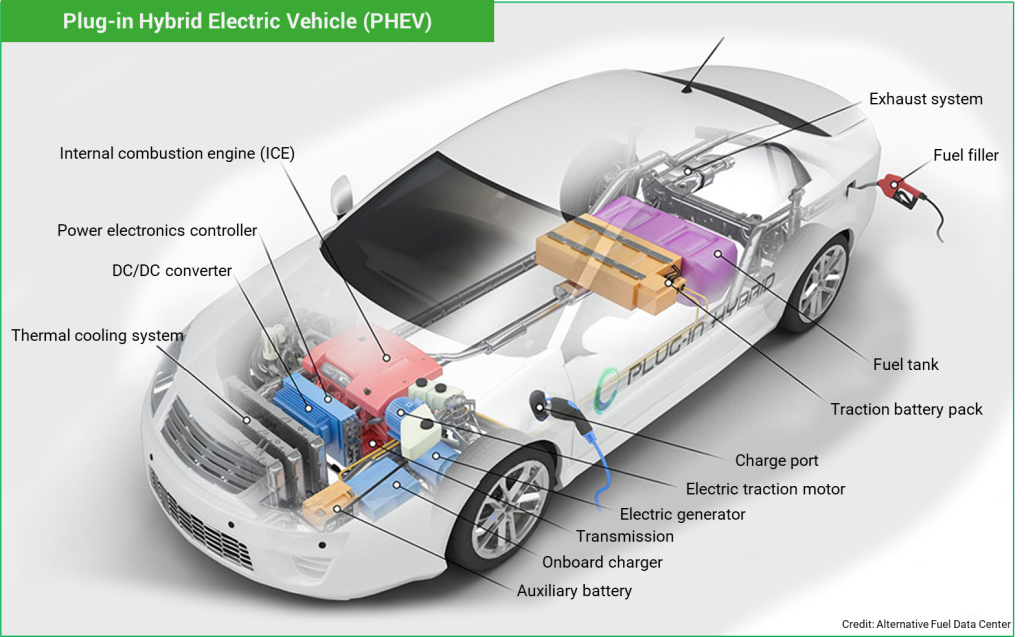
EXAMPLES OF AVAILABLE PLUG-IN HYBRID ELECTRIC VEHICLES (PHEVs)
- Kia Optima PHEV
- Land Rover Range Rover PHEV
- Lincoln Aviator Grand Touring
- Mercedes C300e
- Mini Cooper SE Countryman
- Mitsubishi Outlander PHEV
- Porsche Cayenne S E-Hybrid
- Skoda Octavia iV
- Subaru Crosstrek PHEV
HYBRID ELECTRIC VEHICLES (HEVs)
Hybrid Electric Vehicles (HEVs), or “self-charging hybrids,” combine an internal combustion engine with an electric motor powered by a battery pack. Unlike PHEVs, HEVs cannot plug into an EV charger; the battery charges via the engine and regenerative braking. The electric motor supplements power, often allowing a smaller engine, reducing idling, improving fuel economy, and lowering emissions. Toyota popularized HEVs with the Prius.
Types of HEVs:
- Mild Hybrid Electric Vehicles (MHEVs): Use the battery and motor to assist the engine and shut it off when stopped. Cannot drive on electricity alone and are less fuel-efficient than full hybrids.
- Full Hybrid Electric Vehicles (FHEVs): Feature larger batteries and stronger motors, enabling short-distance travel at low speeds on battery power alone.
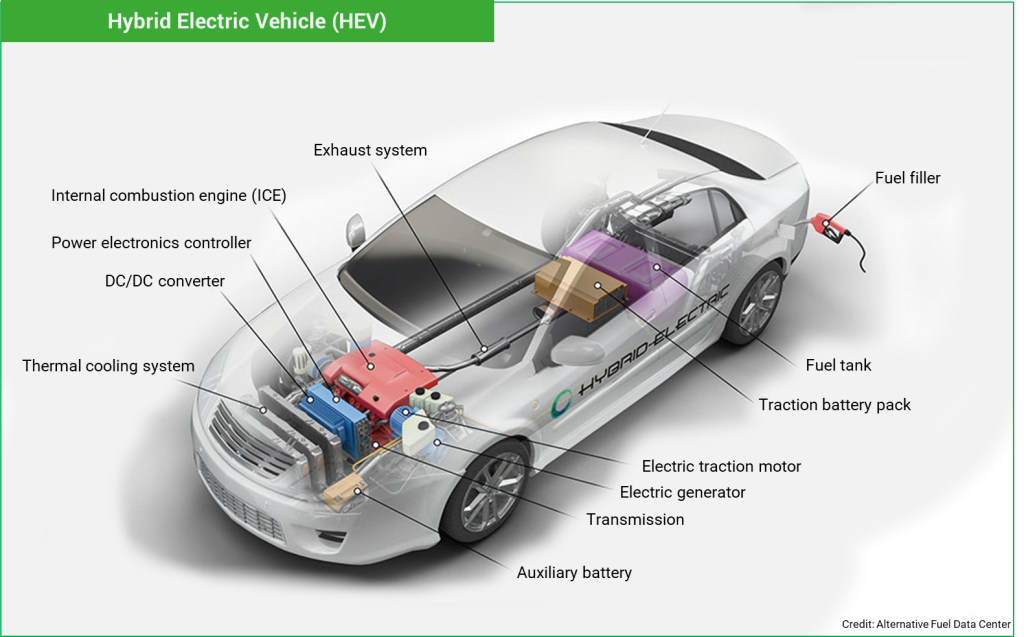
EXAMPLES OF AVAILABLE HYBRID ELECTRIC VEHICLES (HEVs)
- Buick LaCrosse
- Dodge Ram 1500 eTorque
- Ford Focus MHEV
- Ford Mondeo Hybrid
- Honda CR-Z
- Honda Insight
- Hyundai IONIQ Hybrid
- Hyundai Tucson 48V
- Kia Niro Hybrid
HOW DO HYBRID ELECTRIC VEHICLES WORK?
Hybrid vehicles combine power from an electric motor and an internal combustion engine in different ways. First, a Parallel Hybrid connects the engine and motor to the wheels via mechanical coupling, allowing both to drive the wheels directly. Next, Series Hybrids rely solely on the electric motor to power the wheels and are often called Extended-Range (EREVs) or Range-Extended Electric Vehicles (REEVs). Finally, Series-Parallel Hybrids let the engine, motor, or both power the vehicle, optimizing engine performance.
Below, we illustrate how mechanical and electric power is delivered in hybrid cars.
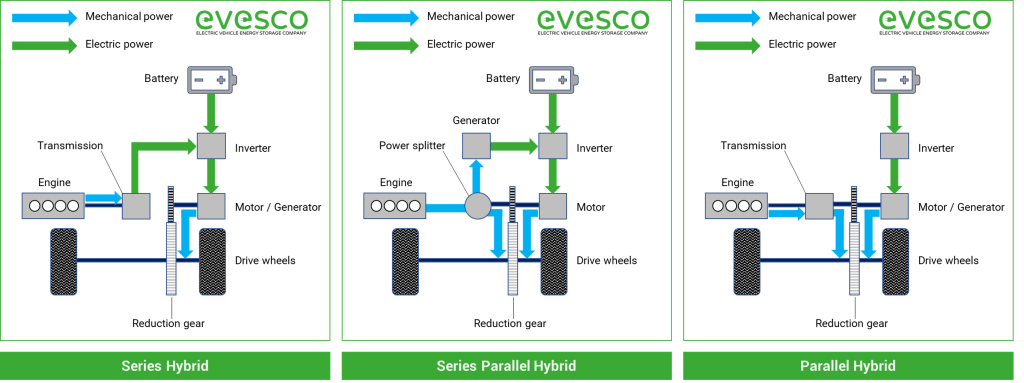
FUEL CELL ELECTRIC VEHICLES (FCEVs)
Fuel Cell Electric Vehicles (FCEVs) create zero tailpipe emissions and are powered by hydrogen. Similar to a Battery Electric Vehicle, an FCEV uses electricity to run the vehicle; however, in this case, the energy is stored as hydrogen and then converted into electricity by the fuel cell to propel the vehicle. Additionally, FCEVs have a gas tank that stores pure hydrogen, which can be refilled in just a few minutes, much like conventional ICE vehicles.
Moreover, FCEVs can travel around 300 miles on a single tank of hydrogen. They also use regenerative braking technology to capture energy lost during braking, storing it in a battery pack. However, there are currently a limited number of FCEVs available to the public, and the refueling infrastructure is not yet sufficient to support a mass rollout.
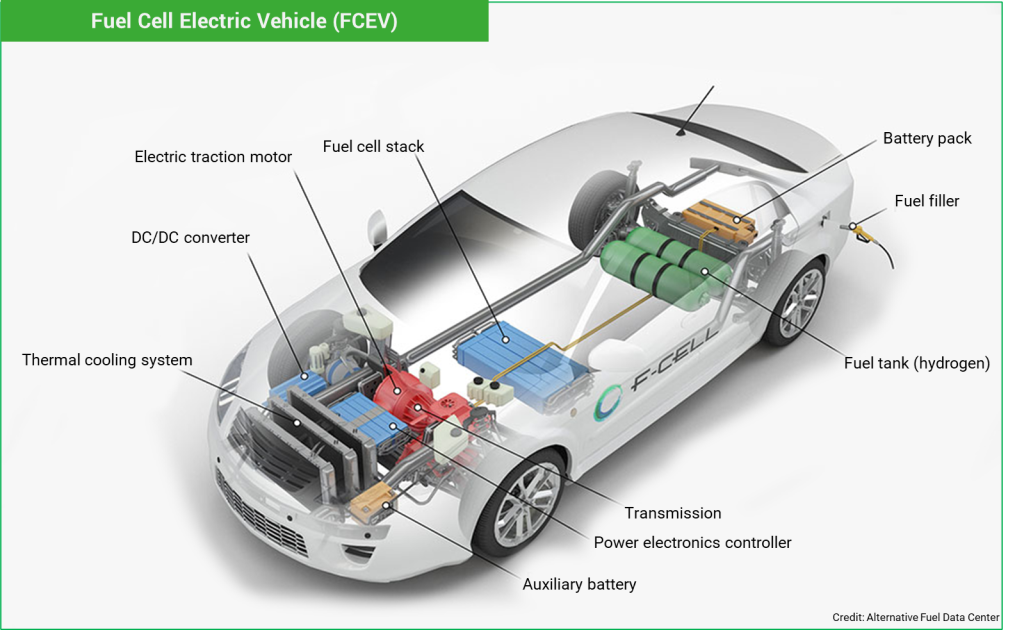
EXAMPLES OF FUEL CELL ELECTRIC VEHICLES (FCEVs)
BMW iX5, Honda Clarity, Hyundai Nexo, Hyundai Nexo Blue, Hyundai Staria Fuel Cell, Ineos Grenadier Hydrogen, Kia FK, Land Rover Defender Fuel Cell, Range Rover FCEV, Toyota Mirai LE, Toyota Mirai Limited, Toyota Mirai XLE.
SOLAR ELECTRIC VEHICLES (SEVs)
Solar Electric Vehicles (SEVs) use photovoltaic cells to convert sunlight into electricity, thereby topping up the battery and extending range compared to standard BEVs. Additionally, this free solar energy can lower ownership costs; however, without sunlight, SEVs operate as regular electric vehicles. Furthermore, SEVs can charge via Level 1, 2, or 3 chargers. Notably, companies producing SEVs include Aptera, Lightyear, and Sono Motors.

